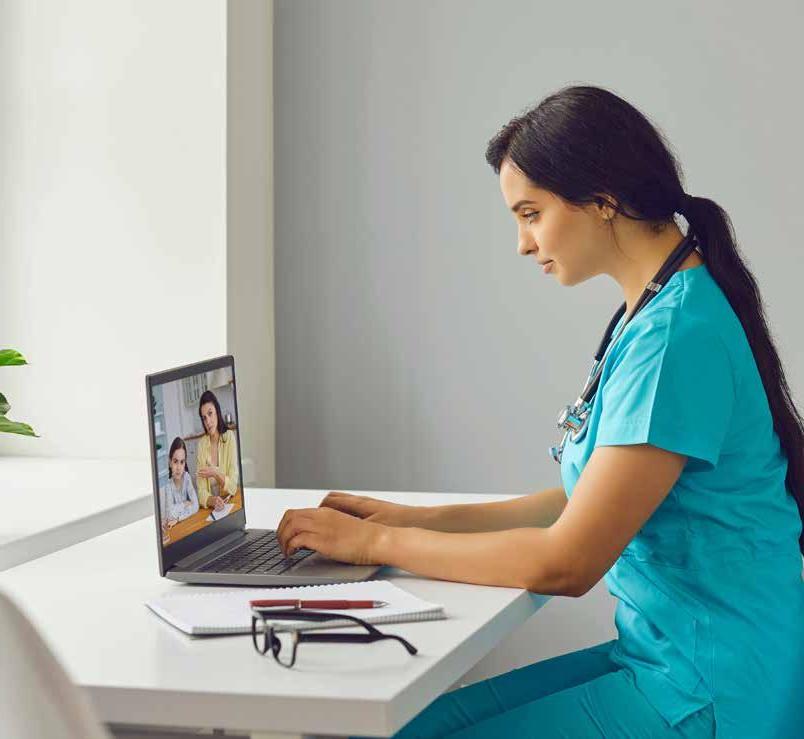
3 minute read
How Hospitals are Embracing Virtual Nursing
BY MICHELE WOJCIECHOWSKI
Nurses are checking on people virtually now, both in-patient and outpatient. Find out how it all works.
During the pandemic, many hospitals began using telehealth, even in the form of virtual nursing. Both Banner Health and New York-Presbyterian Hospital are just two hospital systems that had virtual nursing programs in place prior to COVID-19—but the programs became imperative during the COVID crisis.
Banner Telehealth began with a couple of nurses just working the night shift. Today, 15 years later, 35 nurses work a 24-hour operation, seven days a week. “Our nurses provide a second layer of support for our bedside staff and safety for our patients,” says Zenaida Pena, RN, MSN, RN Manager and TeleICU Nurse for Banner Telehealth for the past 10 years. “During the pandemic, our bedside nurses were incredibly busy providing care to the sickest of the sick. Our nurses rounded on the patients— monitored labs, vital signs, and alarms. In so doing, they were able to prevent sentinel events because they were able to see trends and escalate these patients to our TeleICU providers. . .If the bedside RN is tied up with their other patient, our nurses can keep an eye on their other critical patient, especially during the pandemic when it took longer donning PPE from one patient to another.”
With Banner Telehealth, each TeleICU nurse monitors between 65-75 patients per shift. Pena explains that they monitor patients as well as “their vital signs, labs, orders, EKG rhythms, alarms, and overall status. The level of monitoring depends on the acuity of the patient. They reach out to the bedside nurse if they find something that needs care and attention. They also escalate issues or concerns to the TeleICU intensivists or nurse practitioners.” In addition, Pena says that these virtual nurses also input valuable and reportable information via their documentation—like the APACHE patient scoring, ICU and hospital length of stay, as well as ventilator days.
All the TeleICU nurses work at Banner Health’s facility in Mesa, Arizona, which is designed for in-patient care. “We monitor all patients in the ICU of most of our Banner Health facilities in the multiple states where we have presence—Arizona, Colorado, Nevada, and Wyoming,” says Pena. “During the pandemic, we had many cameras which were deployed in multiple nonICU units which allowed our providers to deliver assistance to any patient when needed.”
Virtual nursing also helped New York-Presbyterian Hospital (NYP) during the toughest days of COVID. “The Clinical Operations Center is a remote monitoring command center where nurses can track physiological data for patients,” says Victoria L. Tiase, PhD, RN-BC, FAMIA, FAAN, Nurse Informaticist and Director of Research Science for NYP. “This was of great importance during the COVID surge. As patients were triaged home with pulse oximeters and oxygen concentrators, nurses were able to virtually connect with patients in their homes.”
In 2016, NYP launched a number of telehealth services, including virtual nurses. Today, they have nurses who support call centers and handle case management. These nurses all work at NYP and speak with patients either by phone or through the patient portal and mHealth application called NYP Connect.
“There are multiple programs that utilize nurses. For instance, patients can share information on blood pressure, weight, glucose level, and other vitals. Nurses can monitor from a distance and send surveys to patients to check in on [their] status. NYP has programs that have been piloted with diabetes patients and congestive heart failure patients,” explains Tiase.
Initial drawbacks with the program were engaging the right patient populations as well as having training materials in multiple languages, says Tiase. The biggest rewards for nurses are “leveraging technology to create efficiencies in nursing workflows and reduce the documentation burden of clinicians. The remote aspect in tracking patients from afar and the ability to monitor progress can potentially reduce readmissions or transfers to a higher level of care.”




